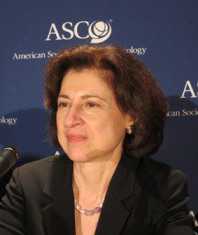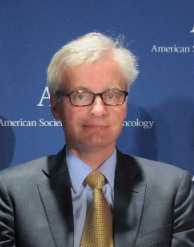青年白血病患者采用儿童方案治疗效果劣于儿童
2012-06-05 不详 网络
芝加哥(EGMN)——美国临床肿瘤学会(ASCO)年会报告的一项临床试验表明,青少年和年轻成人(AYA)白血病患者接受儿童方案治疗,可改善5年无事件生存率,但疗效仍不及儿童患者。 在这项由儿童肿瘤协作组完成的随机III期试验中,研究者入组2,571例最大年龄为30岁的AYA患者,以比较高危B-前体细胞急性淋巴细胞性白血病(ALL)治疗方案效果。其中,501例患者年龄≥16岁。既往

芝加哥(EGMN)——美国临床肿瘤学会(ASCO)年会报告的一项临床试验表明,青少年和年轻成人(AYA)白血病患者接受儿童方案治疗,可改善5年无事件生存率,但疗效仍不及儿童患者。
在这项由儿童肿瘤协作组完成的随机III期试验中,研究者入组2,571例最大年龄为30岁的AYA患者,以比较高危B-前体细胞急性淋巴细胞性白血病(ALL)治疗方案效果。其中,501例患者年龄≥16岁。既往经验表明,该年龄组患者预后劣于儿童患者。
主要作者、缅因州儿童癌症项目医学主任、儿童肿瘤协作组AALL0232方案研究主席Eric Larsen博士报告的结果表明, AYA患者5年无事件生存率为68%,高于既往试验的50%~60%,但低于儿童患者的80%(P<0.0001);AYA患者总生存率(79.8% vs. 88.4%,P<0.0001)和缓解率(97.2% vs. 98.8%,P=0.0134)也相对较低,后者定义为诱导治疗后骨髓原始细胞<5%。研究者认为该差异很大程度上是由于AYA患者骨髓复发率较高(15.2% vs. 9.0%,P<0.0007)。虽然AYA患者CNS复发率略高(5.2% vs. 3.7%),但差异并不显著(P=0.5776)。
此外,AYA患者复发率高于儿童,5年累计复发率为21.3% vs. 13.4%(P=0.0018)。尽管诱导治疗死亡率AYA和儿童无显著差异(2.4% vs. 1.8%, P=0.36),但诱导缓解后5年死亡率显著高于儿童(5.5% vs. 2.1%,P<0.0001)。5年后,两个年龄组生存曲线趋于平稳,但仍见缓解,这也凸显了参考指标的重要性。Larsen博士指出:“在临床实践和研究领域,我们从不声称某患者真正治愈,但生存超过5年后,患者复发的可能性非常小。”
Larsen博士在去年年会上曾报告该试验结果,发现给予患者50倍标准剂量的甲氨蝶呤可降低复发率。他指出,该研究是首个入组30岁患者的儿童ALL试验。通常,儿童研究入组患者年龄最高为18岁,但研究者希望AYA患者接受更为积极的儿童治疗方案可以改善预后。
会议主持人、纽约斯隆-凯特林癌症纪念中心妇科肿瘤医学中心主任Carol Aghajanian博士评论称:“这是一个有待研究的领域。我的确见过年轻成人患有儿科肿瘤,该把他们作为典型成人还是作为儿童加以治疗呢?我们需要确认该类患者并对其疾病进行生物学研究,以便明确合适的治疗方案。”
Larsen博士总结指出,上述分析结果提示,要想改善AYA ALL患者预后,应更好地控制疾病进展和降低药物毒性。AYA患者更易耐药,且对副作用也更敏感。AYA患者预后不佳可能与多种因素有关,包括疾病生物学差异导致癌症更具侵袭性和对化疗副作用耐受性较差。此外,还可能包括社会经济因素,因为AYA患者通常为大学生或正在求职者。依从性不好也是预后不佳的一个因素。尽管父母负责儿童口服用药,但青少年有时希望自己服药,结果却并不理想。
作者报告无相关利益冲突。
CHICAGO (EGMN) – Putting adolescent and young adult leukemia patients on pediatric regimens improved their event-free survival rate at 5-years, but they still did not fare as well as younger patients in a clinical study.
The Children’s Oncology Group protocol randomized 2,571 patients up to 30 years of age in a comparison of treatment regimens for high-risk B-precursor acute lymphoblastic leukemia (ALL). Within this population, 501 patients were 16 years or older – an age group that historically has had poorer outcomes than younger patients.
The 5-year event-free survival rate reached 68% among adolescent and young adult (AYA) patients in the randomized phase III trial – better than the 50%-60% consistently reported in previous trials, according to Dr. Eric Larsen, lead author of the study. It fell short of the 80% achieved in younger patients, however (P less than .0001).
The AYA cohort also had lower rates of overall survival (79.8% vs. 88.4%; P less than .0001) and remission (97.2% vs. 98.8%; P = .0134), which investigators defined as less than 5% marrow blasts after induction therapy. They blamed the disparity in large part on a higher rate of marrow relapse in the older patients (15.2% vs. 9.0%; P less than .0007). CNS relapse occurred at a slightly higher rate in the AYA group – 5.2% vs. 3.7%, they noted, but the difference was not significant (P = .5776).
In another comparison, the AYA patients were more likely to relapse – the 5-year cumulative incidence was 21.3% vs. 13.4% for younger patients (P = .0018). Though induction mortality rates were not significantly different between AYA and younger patients, (2.4% vs. 1.8%; P = .36), postinduction remission deaths were significantly higher at 5 years (5.5% vs. 2.1%; P less than .0001).
After 5 years, survival curves tend to flatten for both age groups but remissions are still possible, Dr. Larsen said, underscoring the importance of the benchmark during a press briefing at the annual meeting of the American Society of Clinical Oncology.
“In clinical practice and in the research world we would never declare someone truly cured, but when you are out 5 years, the number of people who are going to relapse is extraordinarily small,” he said.
Dr. Larsen, medical director of the Maine Children’s Cancer Program, Scarborough, and study chair of the Children’s Oncology Group protocol AALL0232, presented the analysis June 2 at the society’s annual meeting. He reported outcomes of the trial – it found that giving patients 50 times the standard methotrexate dose reduces recurrences – last year at ASCO.
The study was the first pediatric ALL trial to include patients up to 30 years, he noted. Typically, pediatric studies enroll patients up to 18 years of age, but investigators hoped to improve the outcomes of the AYA age group by delivering more aggressive regimens than are typically used in adult patients.
“This is an underserved area,” commented Dr. Carol Aghajanian, moderator of the news briefing and chief of the gynecologic medical oncology service at Memorial Sloan-Kettering Cancer Center in New York.
“I do see young adults ... who have pediatric tumors,” she said in an interview. “Do I treat them as a typical adult or as a child who is much younger? We have this group that gets lost in the middle because of their unique situation.
“We need to identify these patients and do studies that define the biology of their disease [and] what the right treatments are,” she added.
What the current analysis has shown is that “future strategies to improve outcome in AYA patients with ALL should focus on both better leukemia control and reduced treatment toxicity,” Dr. Larsen said in a summary of the findings. AYA patients “have more resistant leukemia and they are more susceptible to side effects,” he added in an interview.
Many factors are thought to contribute to the poorer outcomes in AYA patients, according to Dr. Larsen. These include differences in disease biology leading to more aggressive cancers and less tolerance of chemotherapy side effects than is seen in pediatric patients. In addition, socioeconomic factors may be involved, as AYA patients are often in college or looking for jobs.
本网站所有内容来源注明为“梅斯医学”或“MedSci原创”的文字、图片和音视频资料,版权均属于梅斯医学所有。非经授权,任何媒体、网站或个人不得转载,授权转载时须注明来源为“梅斯医学”。其它来源的文章系转载文章,或“梅斯号”自媒体发布的文章,仅系出于传递更多信息之目的,本站仅负责审核内容合规,其内容不代表本站立场,本站不负责内容的准确性和版权。如果存在侵权、或不希望被转载的媒体或个人可与我们联系,我们将立即进行删除处理。
在此留言












#治疗效果#
26